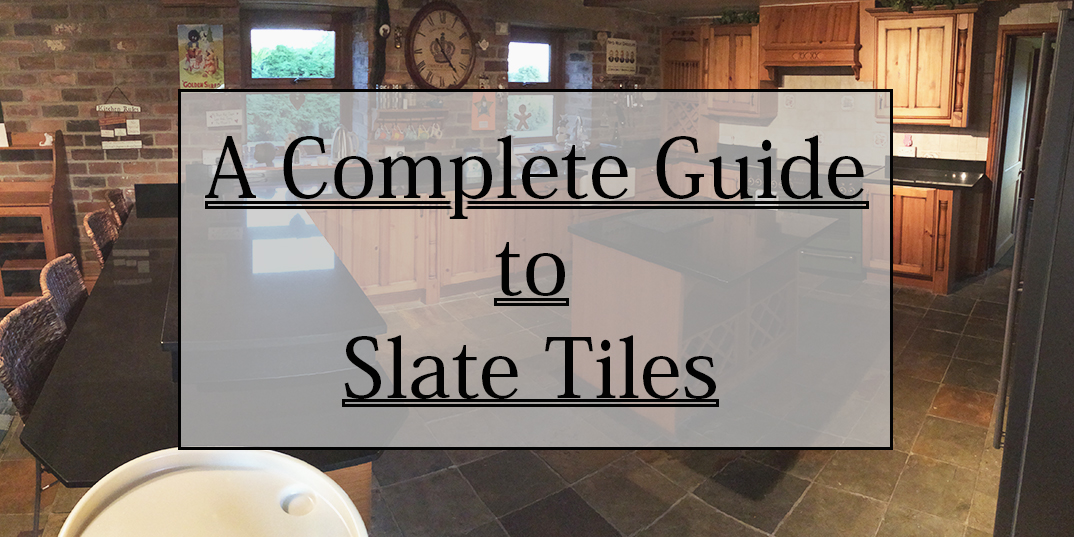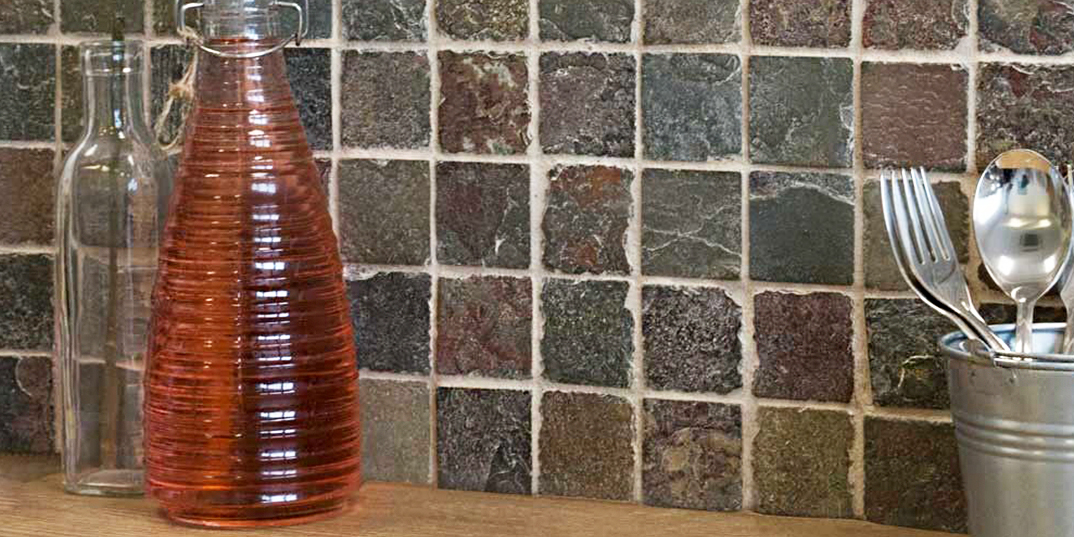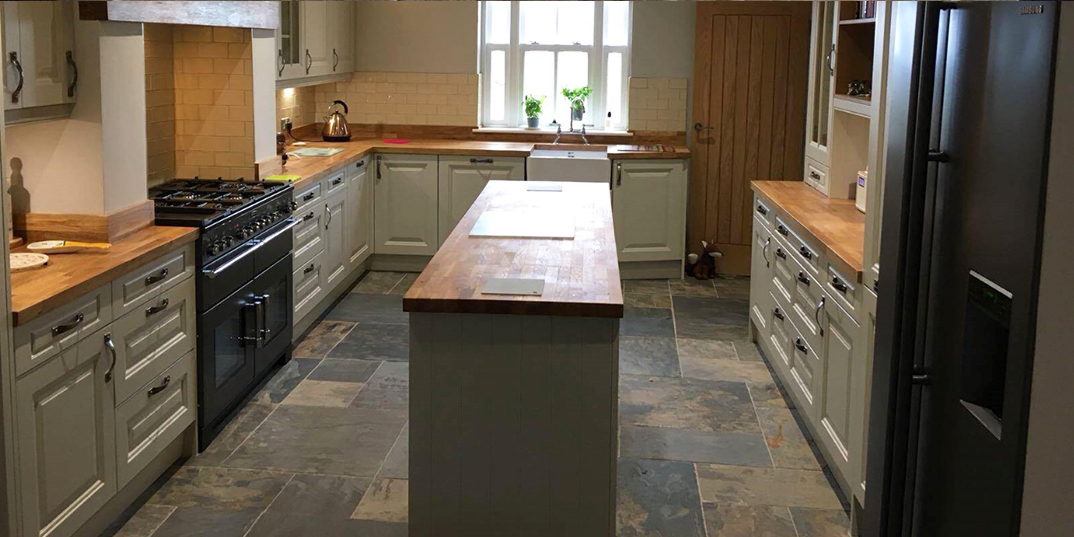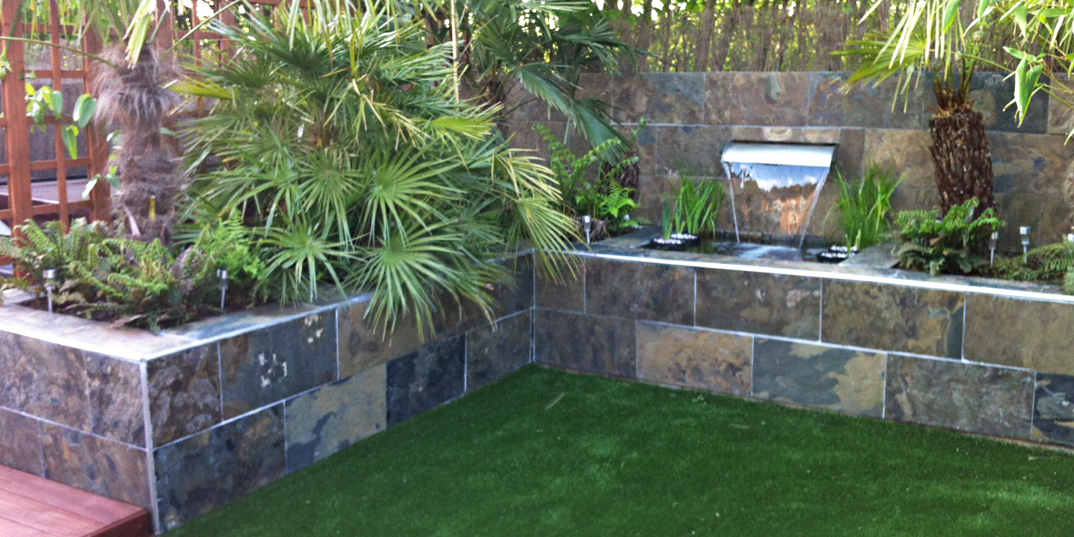Cookie
This website requires cookies to provide all of its features. For more information on what data is contained in the cookies, please see our Privacy Policy page. To accept cookies from this site, please click the Accept button below.


Natural stone slate is renowned as an excellent roof material but did you know that it can be put to equally good use on walls and floors throughout the interior and exterior of your home? Slate is extracted from the ground in large slabs before being cut to be used in various ways. The traditional colour of slate is grey but it is also available in other colours including multi slate. In addition to natural stone slate, porcelain tiles with a slate appearance are also chosen for interior designs. Below we are going to take a look at how slate can be used to transform the look of both your interior areas and exterior including gardens and as paving.
Slate is a metamorphic rock with a fine grain composition. It is formed in sedimentary layers which are compressed together. This formation through compression means that slate has a low moisture absorption rate which explains its regular use as a roof material. Slate is made from clay and volcanic ash. Minerals which are frequent in slate include quartz, muscovite and illite. In slate quarries, a specialised tool is used to cut the slate by striking parallel with foliation. Slate is extracted in flat smooth sheets. Slate has a distinctive riven surface which provides an additional style feature. In addition to roof tiles it has also commonly been used as a surface upon which to write with chalk.


Grey is the most prevalent colour when it comes to slate tiles. Most of the slate extracted from the ground has a grey colour. The shade in question can vary from light to a darker charcoal colour. Grey is a highly versatile colour which works superbly as part of a vast array of design layouts. Grey tiles match well with brown wooden applications like worktops and units. Grey slate is regularly incorporated within modern bathroom and kitchen designs. Grey is such a versatile colour and is one of the most popular options for home interiors. One of the many great things about grey is that it matches so well with other popular colours like black and white. This colour has a real understated quality which is excellent for classy and sophisticated decors.


The clue is in the name, Multi Slate Tiles comprise of multiple colours which often include grey, red and brown. These tiles certainly provide a standout appearance in both interior and exterior areas. They are an excellent choice for areas of flooring and provide genuine character. These tiles are well suited to larger style kitchens, particularly those which have an island unit and an open plan layout. The unique look of these tiles can transform any part of your home or garden. You can provide both interiors and exteriors with a standout appeal by choosing these tiles. The various colours and features of multi slate tiles can be enhanced further with tile sealant.


The incredible look and style of natural slate has also been encapsulated within slate effect tiles. Porcelain tiles which have a slate appearance can provide a practical and low maintenance alternative to genuine slate. Slate Effect Porcelain tiles are chosen for various designs, including homes, shops and offices. These tiles are not just available in traditional slate colours like grey but also white and cream. Tiles with a slate appearance are well suited to modern bathrooms and kitchens. In bathrooms, slate style tiles can be used as part of shower area walls, on floors and also as part of a sink or bath surround. In kitchens, these tiles are often preferred as a floor covering and arranged within a running bond (brick style) design.


Whether you are choosing limestone wall tiles to match the floor design or you are contrasting it with a different material, this natural stone is certainly an excellent option for this area. Limestone as part of a kitchen backsplash will provide a fresh and invigorating style. Polished limestone on walls creates a surface which is easy to clean and maintain and this is important in an area which is susceptible to the build-up of moisture and also discolouring from food. For the backsplash, you could even choose limestone style stone cladding. The rustic style of stone cladding can be emphasised further by spotlights being placed beneath the kitchen units. For the wall design in your kitchen, you can choose from either square or rectangular tiles. Large tiles, even as part of small backsplash areas, will result in fewer grout lines and therefore less places for the accumulation of dirt and grime. The use of smaller tiles as part of a more intricate design, however, can offer a really decorative appearance. These natural tiles on kitchen walls are ideal for introducing a truly incredible character and will transform the interior layout.


As a result of its unique look and practical qualities, slate tiles have become a sought after option for home interiors. It is used in many parts of the home, on both walls and floors, offering a rustic character and durable covering. Slate is also more affordable than other varieties of natural stone like marble and granite. If you are choosing slate tiles for your home you have plenty of choice when it comes to formats, sizes and styles. In terms of format, both square and rectangular slate tiles are available. When it comes to sizes, slate can be available in a large 600x600mm size and also a smaller 300x300mm size. You can also choose slate mosaic tiles which can be used as backsplash or feature. The use of a specialist sealant during the installation process is often recommended for slate to avoid damage or staining from moisture. Sealant can also enhance the overall look of the tiles.


Whether you’re looking to transform a standard bathroom, downstairs toilet or en suite, slate tiles may just be the perfect option. If you choose grey slate tiles then this colour is certainly well suited to modern bathrooms as it matches superbly with white fittings and clear glass shower screens. Rectangular slate floor tiles can be laid as part of a running bond pattern on floors in contemporary bathrooms. If you are looking for a stylish, textured wall feature then splitface slate effect tiles are an excellent choice. The look of splitface tiles can be emphasised further by ceiling spotlights. Bathrooms with a natural appearance certainly provide a wow factor that will amaze you guests.


There are various ways in which you can incorporate slate tiles within your kitchen layout. Slate works extremely well with wood units and worktops as part of farmhouse style kitchens. Multi Slate tiles are the preferred choice when it comes to creating a traditional farmhouse style kitchen. Within this type of design, slate floor tiles can be complemented by brick slips or metro brick tiles in order to continue the rustic theme. In kitchens, the hardwearing nature of slate is ideal as a floor covering as this is a part of the home which can experience high levels of foot traffic, particularly if it is also used as a dining area. On floors, a running bond grey slate design can be emphasised by a lighter coloured grout.


Introduce a unique charm throughout your hallway with slate tiles. These natural stone tiles can be incorporated within a hallway interior as a floor covering. The rustic quality of slate can really wow your guests as they enter your home. A popular technique is to complement slate floor tiles with brick effect wallpaper in hallways. The natural riven finish of slate can provide a surface with a high level of slip resistance which is particularly sought after for hallway designs. This natural stone is perfect if you are looking to introduce an understated and classy feel. You can use slate effect porcelain tiles on floors in hallways and even create a warm surface with Electric Underfloor Heating. If you are lucky enough to have a porch then slate tiles are well suited to these areas too and will provide both a stylish and practical floor covering at the entrance to your home.


Many people have conservatories which they enjoy relaxing in, particularly during the warmer months. A conservatory can prove to be quite a high traffic area as it is a natural walkway from the interior to the exterior of your home and vice versa. For this reason it requires a hardwearing floor covering which can withstand the demands of people walking in outdoor footwear, the presence of potentially heavy furniture and general wear and tear. Limestone tiles are therefore an outstanding choice for conservatory floors. Limestone floor design will complement a traditional half bricked conservatory wall. A sought after option for modern interior conservatory walls are Brick Slips as they are lightweight and can be applied to a range of wall substrates. You could also choose limestone for your conservatory walls too with the light, soft colours offering a shimmering glow with the bountiful natural sunlight these areas are exposed to. If you have chosen limestone for your conservatory floor then for a consistent theme you may want to select limestone for other floor areas throughout your home.


The versatility of slate means it can be used as either a wall or floor covering throughout a living room. On floors, slate can make a real statement. It is well suited to floors as part of an open plan design and can be complemented by other natural materials like wood and stone. On walls, natural slate tiles can be incorporated within a feature or as part of a fireplace surround. Splitface slate tiles have a textured surface and are also recommended if you are on the lookout for an eye-catching feature on living room walls. Once again, it is the classic running bond (brick style) slate arrangement which is best suited to living room floors. In living rooms you can protect the surface of slate tiles and also enhance the appearance by applying Impregnating Sealer. This sealer can be applied again at times when you feel the slate is beginning to lose its colour and also its resistant properties.


With the combination of extreme strength and timeless neutral colours, it is no surprise that limestone has been used in the world of construction for many years. As a building material, not only has limestone been used as blocks in order to construct walls and foundations but is also a key component within concrete. Limestone is also crushed and used as a base for roads. It is the second most widely used building stone in the world and is particularly popular because of its soft nature and the ease at which it can be carved. The consistency of both the colour and texture of limestone are also big selling points when it comes to its use within the construction industry.


In addition to homes, slate tiles are also chosen for a vast array of commercial projects. Slate is well suited to country farmhouse pubs and restaurants. This not only applies to the interior of these buildings but also the exterior including patios and entrances. The rustic charm of slate is also capable of transforming shops and cafes. Large format Slate Tiles, including those in a 600x600mm size, are chosen for the expansive parts of commercial properties. Slate is well suited to high traffic areas within busy public spaces. Slate adds a unique look and also texture to commercial layouts and offers a timeless appeal.


Limestone is a sedimentary rock which is formed through the precipitation of calcium carbonate and the skeletal fragments of marine organisms. It is formed in clear, warm, shallow water near hot natural springs. The formation process creates a rock which is pale in colour, usually an off white ivory or a light cream shade. Due to the impurities in limestone it is very rarely a pure white colour. Much of the limestone in the world was formed over one million years ago and is made up of around 50% calcium carbonate. The true beauty of this natural stone is apparent within limestone caves which contain stalactites. Stalactites occur when water containing calcium bicarbonate drips from the ceiling of the limestone cave and precipitates back in to limestone when it comes in to contact with air and elongates in to stalactite form.